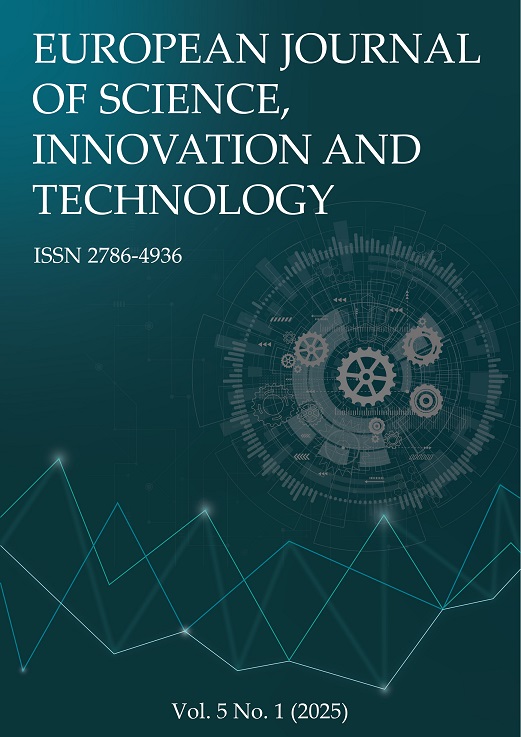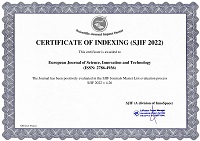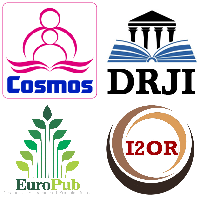Design of a Gas Turbine for the Conversion of Flare Gases to Energy Using Aspen HYSYS: A Case Study of an Oil Field in Niger Delta
Abstract
Gas flaring is among the main issues being discussed in the oil and gas industry for decades now. The present study is motivated by concerns over the environmental impact associated with gas flaring activities in the industries and the economic waste. The case study selected was from an oil mining lease in Nigeria. A total volume of gas flared daily for a period of June, July and August, 2022 along with the analyzed composition of the flare gas was collected. The volume of gas flared daily was estimated as 13,000 Sm3 per day which is equivalent to 542 m3/h flowrate. The combined cycle energy plant (gas turbine-steam turbine systems) simulation carried out in Aspen HYSYS v.10 using Peng-Robinson fluid package, a 98.61% removal of CO2, H2S and other heavier hydrocarbons in the flare gas was achieved in the flare gas absorber and separator units. The net energy output from the combined turbine plant was found to be 346.5MW of electricity daily; this is sufficient enough to power Port Harcourt city. Estimation of the total capital and operating costs was performed using Aspen Process Economic Analyzer (APEA), total capital cost of 67,907,300 USD, total operating cost of 19,345,800 USD/Year, total utilities cost of 14,247,500 USD/Year, equipment cost of 45,097,500 USD, and total installation cost of 48,724,000 USD. This shows that the model used in this work can solve the problem of gas flaring in an oil mining lease in Niger Delta.
References
Addeh, E. (2023). 10 Billion SCF of Gas Flared in December Despite Nigeria’s NetZero Commitments. Thisday. [Accessed 12th November, 2023]
Akinola, A. O. (2018). Resource misgovernance and the contradictions of gas flaring in Nigeria: A theoretical conversation. Journal of Asian and African Studies, 53(5), 749–763.
Akintayo, O. (2023). Govt loses N847bn to gas flaring – NOSDRA. Punch. [Accessed 5th October, 2023]
Dinani, A. M., Nassaji, A., & Hamzehlouyan, T. (2023). An optimized economic-environmental model for a proposed flare gas recovery system. Energy Reports, 9, 2921–2934.
Edwin, M., Abdulsalam, S., & Muhammad, I. M. (2017). Process simulation and optimization of crude oil stabilization scheme using Aspen-HYSYS software. International Journal of Recent Trends in Engineering & Research, 3(05).
Hassan, A., & Kouhy, R. (2013). Gas flaring in Nigeria: Analysis of changes in its consequent carbon emission and reporting. Accounting Forum, 37(2), 124–134.
Jacques, M. G. (2012). Total Energies Press Releases. Retrieved: Total Energies: www.totalenergies.com/media/news/press-releases/nigeria-total-lance-la-deuxieme-phase-du-development-du-champ-offshore-dofon [Accessed 12th February, 2023]
Liu, Z., & Karimi, I. A. (2018). Simulating Combined Cycle Gas Turbine Power Plants in Aspen HYSYS. Journal of Energy Conversion and Management, 171, 1213-1225.
Mansoor, R., & Tahir, M. (2021). Recent developments in natural gas flaring reduction and reformation to energy-efficient fuels: A review. Energy & Fuels, 35(5), 3675–3714.
Mostafa, J., Mohammad-Hosein, S., & Kamran, G. (2020). Simulation and Economic Evaluation of Heat and Power Generation from Flare Gases in a Combined Cycle Power Plant. Energy Equipment and Systems.
Ojijiagwo, E., Oduoza, C., & Emekwuru, N. (2016). Economics of gas to wire technology applied in gas flare management. Engineering Science and Technology International Journal, 19, 2109–2118.
Petri, Y., Juliza, H., & Humala, N. (2018). Technical and Economic Analysis Use Of Flare Gas Into Alternative Energy As A Breakthrough In Achieving Zero Routine Flaring. IOP Conf. Series: Earth and Environmental Science, 126.
Rahimpour, M. R., Jamshidnejad, Z., Jokar, S. M., Karimi, G., Ghorbani, A., & Mohammadi, A. H. (2012). A comparative study of three different methods for flare gas recovery of Asalooye Gas Refinery. Journal of Natural Gas Science and Engineering, 4, 17–28.
Rahimpour, M. R., & Jokar, S. M. (2012). Feasibility of flare gas reformation to practical energy in Farashband gas refinery: No gas flaring. Journal of Hazardous Materials, 209, 204–217.
Shahab-Deljoo, M., Medi, B., Kazi, M.-K., & Jafari, M. (2023). A Techno-Economic Review of Gas Flaring in Iran and Its Human and Environmental Impacts. Process Safety and Environmental Protection.
Tahouni, N., Gholami, M., & Panjeshahi, M. H. (2016). Integration of flare gas with fuel gas network in refineries. Energy, 111, 82–91.
Ujile, A. A. (2014). Chemical engineering unit operations, synthesis and basic design calculations. Bomn Prints, Ibadan, Nigeria, 61–84.
Umyshev, D. R., Osipov, E. V., Kibarin, A. A., Korobkov, M. S., Khodanova, T. V., & Duisenbek, Z. S. (2023). Techno-Economic Analysis of the Modernization Options of a Gas Turbine Power Plant Using Aspen HYSYS. Energies, 16(6), 2704.
Verdict, M. L. (2016). Ofon Field, Oil and Natural Gas Field. Retrieved: Offshore Technology: www.offshore-technology.com/projects/ofon-field/ [Accessed 12th February, 2023]
World-Bank. (2021). Global Gas Flaring Tracker Report. The World Bank Group.
Copyright (c) 2025 Appolos Gombando Osaro, Awajiogak A. Ujile, Ademiluyi, Falilat Taiwo

This work is licensed under a Creative Commons Attribution 4.0 International License.


 ISSN
ISSN 











